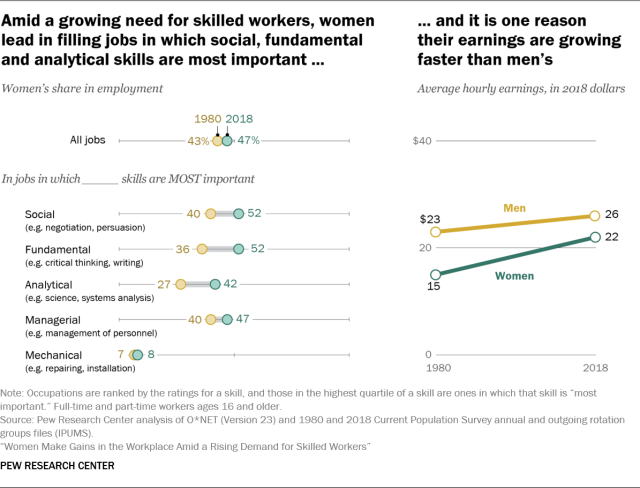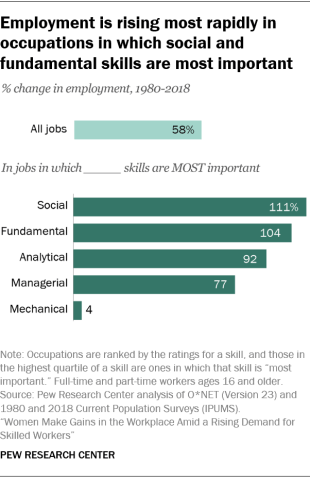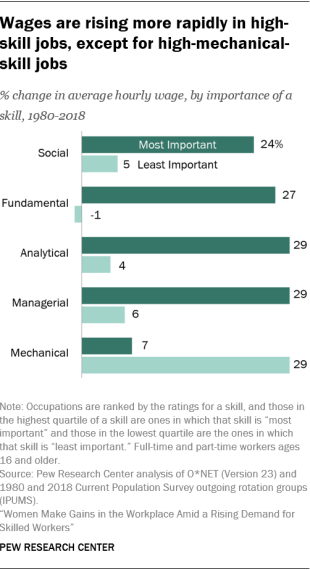By Rakesh Kochhar, senior researcher at Pew Research Center
Pew Research Center, January 30, 2020
There is a growing need for high-skill workers in the American workplace, and this has helped to narrow gender disparities in the labor market, a new Pew Research Center report finds. Increasingly, U.S. employers are in pursuit of workers who are adept in social skills, like negotiation and persuasion, and who have a strong grounding in fundamental skills, such as critical thinking and writing. Jobs attaching greater importance to analytical skills, such as science and mathematics, are also adding workers at a brisk pace. Women have been in the forefront of meeting these challenges, and this has been to their benefit.
Here are seven key findings from the report:
1. Women are in the majority in jobs that draw most heavily on either social or fundamental skills. In 2018, women made up 52% of employment in jobs in which either social or fundamental skills are most important – such as legal, teaching and counseling occupations (up from roughly 40% in 1980). Women also greatly raised their share of employment in occupations in which analytical skills are of greatest importance – such as accounting and dentistry – from 27% in 1980 to 42% in 2018. The increase in the share of women in these high-skill occupations was much greater than the increase in their share of employment overall, from 43% in 1980 to 47% in 2018.

2. The growing presence of women in higher-skill occupations helped to narrow the gender wage gap. As women surged into higher-skill occupations in recent decades, they experienced more rapid wage growth than men. A rising level of education among women was also a contributing factor. From 1980 to 2018, the average hourly wage of women increased 45%, from $15 to $22, compared with an increase of 14% for men, from $23 to $26 (wages expressed in 2018 dollars). Thus, the earnings of women as a ratio of the earnings of men increased from 0.67 to 0.85, a narrowing of the gender wage gap from 33 cents to the dollar in 1980 to 15 cents to the dollar in 2018.
3. Despite women’s advantages in skills and education, the gender wage gap persists and is ubiquitous. Regardless of the classification of occupations – by skill type or the importance of a skill – women’s earnings fell short of men’s earnings in 2018. For example, women in occupations with the greatest need for analytical skills earned $33 per hour, 88% as much as the men who earned $38 per hour in similar jobs. Women in occupations with the least need for analytical skills earned 82% as much as men in the same jobs.

The wage gap persists even though women currently hold an edge over men in certain skills and in schooling. In 2018, women constituted the majority in jobs in which fundamental and social skills are more important. Also, 40% of women had completed at least a four-year college program, compared with 35% of men. The analysis in this report estimates that women’s lead in skills and education helped to narrow the gender wage gap by 4 cents to the dollar. But the ongoing presence of a gender wage gap is attributable to a variety of other factors, some measurable (such as hours worked, industry and occupation) and others more difficult to pinpoint (such as discrimination by race, gender or other characteristics and differences in professional networks).
4. Gender differences in skills are rooted in gender differences in occupations. The skills that women and men deploy at the workplace are influenced by the specific occupations they gravitate to, whether by choice or due to cultural norms and other constraints. Some 61% of women were engaged in administrative support, health care, sales-related, managerial and education-related occupations in 2018 – all jobs more in need of social, fundamental and managerial skills. In contrast, 34% of men were employed in the following lines of work: production, installation and repair; construction, extraction and farming; and transportation and related. These occupations are more in need of mechanical skills.

5. Employment is rising more rapidly in jobs in which social and fundamental skills are most important.From 1980 to 2018, overall employment more than doubled in jobs where social and fundamental skills are most important, by 111% and 104%, respectively. (Examples of such jobs are social workers, lawyers and obstetricians.) Employment in jobs most in need of analytical skills, such as computer programmers, increased nearly as sharply (92%), compared with an increase of 58% in employment overall. Meanwhile, there was virtually no change in employment in jobs relying most on mechanical skills (only 4%). That is at least in part due to globalizationand technological change, which have sharply reduced job opportunities in the manufacturing sector and the need for mechanical skills.

6. Wages are higher and rising faster in jobs that rely heavily on social, fundamental, analytical and managerial skills. When grouped by the importance of these four nonmechanical skills, average hourly wages in 2018 ranged from $29 in jobs in which social skills are most important, such as sales managers, to $36 in jobs in which analytical skills are most important, such as physicists. Jobs in which these skills are least important, such as dishwashers and telemarketers, paid from $15 to $18 per hour, on average. Furthermore, from 1980 to 2018, wages increased by at least 24% in jobs in which social, fundamental, analytical and managerial skills are most important, whereas wages in jobs least in need of these skills were either stagnant or barely changed.
Overall, both rising employment and wages in higher-skill jobs affirm the growing demand for workers more adept in social, fundamental, managerial and analytical skills. Wages vary little by mechanical skills, ranging from $22 to $25 in 2018 depending on the importance of mechanical skills.
7. Emerging occupations call for greater proficiency in analytical skills. The skills profiles of “new and emerging” occupations point to a rising need for analytical skills in the near future. Many of these jobs, such as database architects, informatics nurse specialists and video game designers, reflect the changes driven by modern-day technologies. The average rating of the importance of analytical skills in newer jobs is 21% greater than the average rating in existing jobs. The average rating of social skills in new jobs is 7% greater and the ratings for fundamental and managerial skills are both 10% higher in new jobs. Starting in 2010, the government’s database on job skills used in this report (O*NET) listed 147 occupations as “new and emerging.”
###

Visit Pew Research Center report for the full report.











